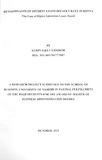| dc.description.abstract | Higher education matters because knowledge for its own sake is important, as is the
transmission of core values for individual life chances and for national economic
performance. The need for greater higher educational capacity, quality, and equity is leading
more and more countries to turn to student loan schemes, both as a form of student assistance
and also as a crucial source of revenue to supplement the increasingly inadequate revenue
available from governments and families.
In Kenya the Higher Education Loans Board has been mandated by HELB Act CAP 213A to
finance students pursuing higher education both within and outside Kenya. It however faces
the challenge of low recoveries, dwindling finances from the Government, increased demand
due to growing student population and rising costs of education. Understanding the
determinants of loan default rates in student loan schemes seems to hold the key to
overcoming the obstacles to student loan default rate.
This study’s objective was to investigate the factors behind high loan defaults and to what
extent they affect student loan default in Kenya. It was a case study of Higher Education
Loans Board. A Theoretical and empirical review of literature on past studies made on the
same were carried out and finally Policy recommendations to minimize loan default
suggested.
This study performed regression analysis on secondary data from HELB database of student
loan beneficiaries whose loans were in default or dormant focusing on factors identified as
critical determinants of default(independent variables) which were; the total amount of loan
advanced, age of student, institution attended and study period. The regression model was
expected to yield probability of default given various levels of the independent variables.
The study found out that the likelihood that a loanee will default on the university loan is
related to a complex web of factors including the total level of debt, the age of student, period
of study and the institution of study among others. It would therefore be difficult for the
lending institution to manage default on the basis of a single factor. Developing a default
management program may be the first step to reducing default rate with the main focus being
to prevent the occurrence of default long before the loan beneficiary graduates. | en_US |

